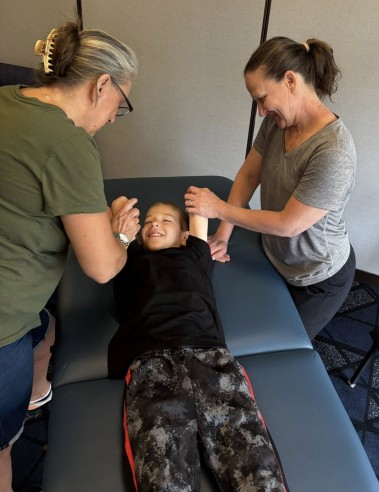
The Method
The Method
The historical and practical origins of the Masgutova Neurosensorimotor Integration (MNRI) Method set it apart from other programs that address reflexes.
From its early roots in Russia in 1989, to Poland and to points around the globe, families and professionals continue to seek out the MNRI Method as they learn about its potential of positive change from friends and colleagues. If you are not familiar with the important role automatic motor reflexes and their underlying neurosensorimotor mechanisms play, we invite you to learn more here, as we explain the basic dynamics important to this understanding. We encourage you to qualitatively deepen the understanding you gain here by listening to what parents and professionals who came before you have to say. Each share their personal experience with the MNRI Method and relate the real world impact it has had on lives of people they know. While each experience presents its own twists and turns, fundamentally the same two factors underlie the desire to continue using the Method and to share knowledge of the Method with others – The ability to impact change with such a simple set of tools and the ability to make someone’s life easier.
 While, the basic concept of reflexes is generally familiar to most people (e.g., knee jerk reaction, Pavlov’s dogs), the nuances associated with various types of reflexes is often less well understood. Our goal is to help you understand the difference between automatic motor reflexes and learned motor reflexes, the role of simple to more complex automatic motor reflexes in establishing a solid developmental foundation, and how reflexes work to automatically regulate each of our bodies under normal conditions in reaction to normal stress, or traumatic situations. This basic information can help you better understand why primary motor reflex patterns (sometimes referred to as primitive reflexes or infant reflexes), in particular, play such a big roll in maturation, development, and normal life function.
While, the basic concept of reflexes is generally familiar to most people (e.g., knee jerk reaction, Pavlov’s dogs), the nuances associated with various types of reflexes is often less well understood. Our goal is to help you understand the difference between automatic motor reflexes and learned motor reflexes, the role of simple to more complex automatic motor reflexes in establishing a solid developmental foundation, and how reflexes work to automatically regulate each of our bodies under normal conditions in reaction to normal stress, or traumatic situations. This basic information can help you better understand why primary motor reflex patterns (sometimes referred to as primitive reflexes or infant reflexes), in particular, play such a big roll in maturation, development, and normal life function.
Fundamental to the MNRI Method is the understanding that automatic primary motor reflex patterns do not disappear, they integrate. While most people in the general health and wellness community are quite familiar with primary motor reflex patterns, they generally view the patterns as developmental milestones. In the course of working with a patient, if primary motor reflex patterns are found active beyond the expected or typical developmental time period, the presence of the pattern is viewed as an indication that underlying developmental or neurological issues may exist. Within the framework of the MNRI Method, primary motor reflex patterns play a much larger role. First, it is important to understand that reflexes do not function in complete isolation of one another. Primary motor reflex patterns, in particular, play a subordinate role in the maturation of more complex motor reflex schemes (i.e., rolling over, sitting up, crawling, etc.) Once a primary reflex pattern fully matures during the typical developmental period, it integrates to serve this subordinate role. A dysfunctional pattern results either because it did not mature and integrate in the first place or because it has re-surfaced at some point after integration. In other words, a dysfunctional primary reflex pattern is not simply an indictor of potential neurological dysfunction, but actually helps to identify where underlying neurosensorimotor dysfunction exists in the body. The MNRI Method isolates reflex dysfunction, engages restorative techniques targeting underlying neurosensorimotor dysfunction, and works toward facilitating the integration process, resulting in improvements and sometimes even complete recovery of general function.
While the broader importance of primary motor reflex patterns and general concept of primary reflex integration may seem new, they are not. The perspective that the MNRI Method is based upon is simply a less well known perspective. At its core, the MNRI Method is designed to facilitate the emergence, maturation, and integration process of primary reflex motor patterns for anyone, regardless of condition or age. To support the integration of primary reflex motor patterns, MNRI Method program techniques have also been developed to integrate motor reflex movements (subordinate components of primary motor reflex patterns) and tactile, visual, auditory, and proprioceptive sensory systems. The following links contain information about the origins of the MNRI method, the importance of reflexes, and the MNRI Method approach and programs. As you move forward we ask you to share this basic information with others and to direct them to our site. In this way, the important role automatic reflexes serve will be better understood by all who have the potential to impact positive change.


